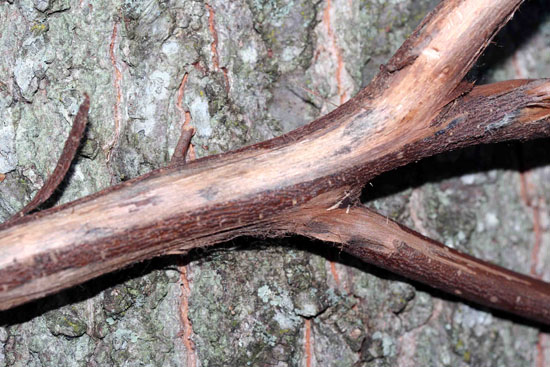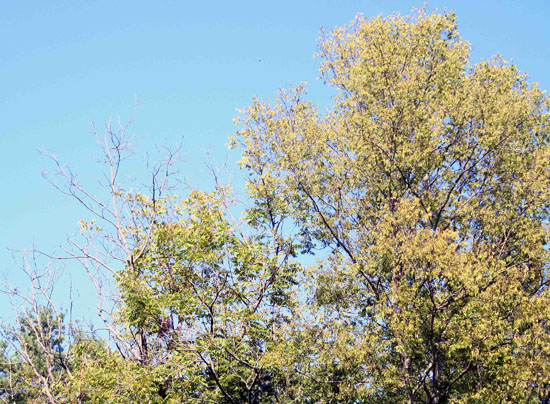Issue 16, September 10, 2010
Thousand Cankers Disease
Thousand cankers disease, Geosmithia sp., and its vector, walnut twig beetle has been found in black walnut, Juglans nigra, for several years from the Rocky Mountains on west. In August, it was found in the Knoxville, Tennessee area. Last week, Jim Schuster, University of Illinois Extension Plant Pathologist, and I were able to visit the area and view the problem first hand. This is a disease that kills healthy black walnut trees; there is no effective treatment.
Affected trees have thin canopies of yellowish leaves. There is an increase in water sprouts on the trunk and bases of lower scaffold branches. This progresses to dieback in the canopy as well as scattered dead branches lower on the tree. Eventually, the entire tree dies. In later stages of the disease, large numbers of wilted leaves are commonly present. Affected branches of about one-half inch in diameter and larger have many brown to black cankers under the bark that are about one-quarter to one-half inch long by about half as wide. Initially, cankers form beneath leaf and twig scars. On smaller branches, the bark is darker and sunken over cankers. Another fungus, Fusarium solani, is also associated with the cankers. Branches die as cankers increase and spread to cover the circumference of the branch, girdling it.

Thousand cankers on black walnut twig.

Thousand cankers on black walnut showing wilting, yellowing leaves, and dead branches.
Trees with advanced disease symptoms develop a second type of canker on the trunk. These are dark brown to black, macerated, water-soaked, and may be six feet or more in length. Black staining is usually noticeable on the bark surface or in cracks in the bark.
It is thought that thousand cankers disease originated in Arizona walnut, Juglans major, a species of walnut native to Arizona, New Mexico, and northern Mexico. It apparently moved, with walnut twig beetle, into black walnut planted in that part of the continent. From there, it apparently moved to various areas of the western U.S., having been common in black walnut trees in California for many years.
Thousand cankers disease is not found without the walnut twig beetle. It is unlikely that a bark beetle as small as walnut twig beetle flies very far, so that type of spread should be very slow. Movement is much quicker by people transporting logs and firewood. Black walnut logs are commonly shipped from the Knoxville, TN area into Indiana, making it likely that the disease and beetle are already located there.
Be watchful for black walnut trees in decline from the top down and very tiny, round emergence holes in the bark. Peal back the bark to check for numerous cankers in the cambium. Report any finds to your local Illinois Department of Illinois field person, to your local Extension office, or to me. Additional information can be found in this Colorado State University pest alert (Adobe PDF).--Phil Nixon
Author:
Phil Nixon